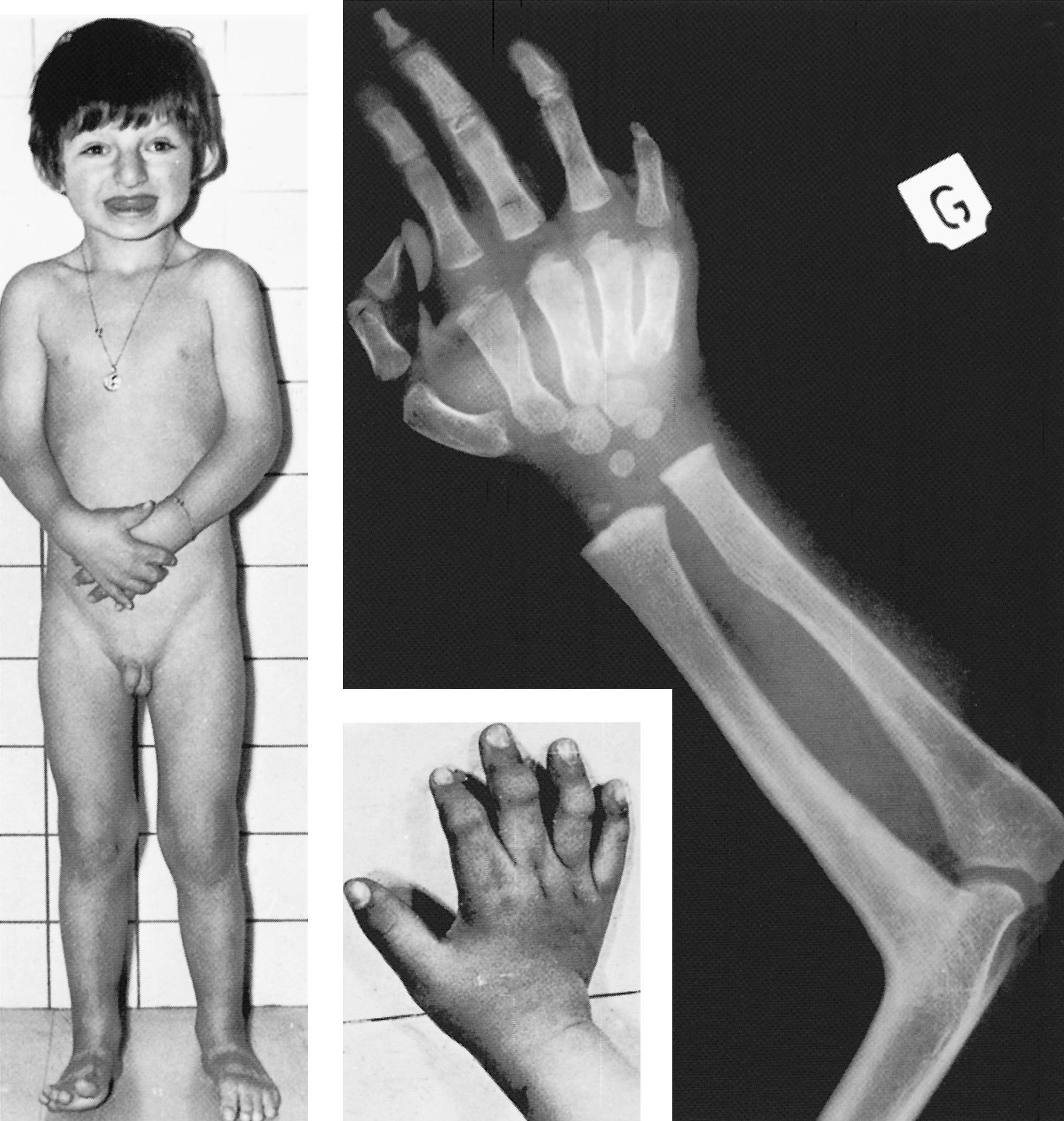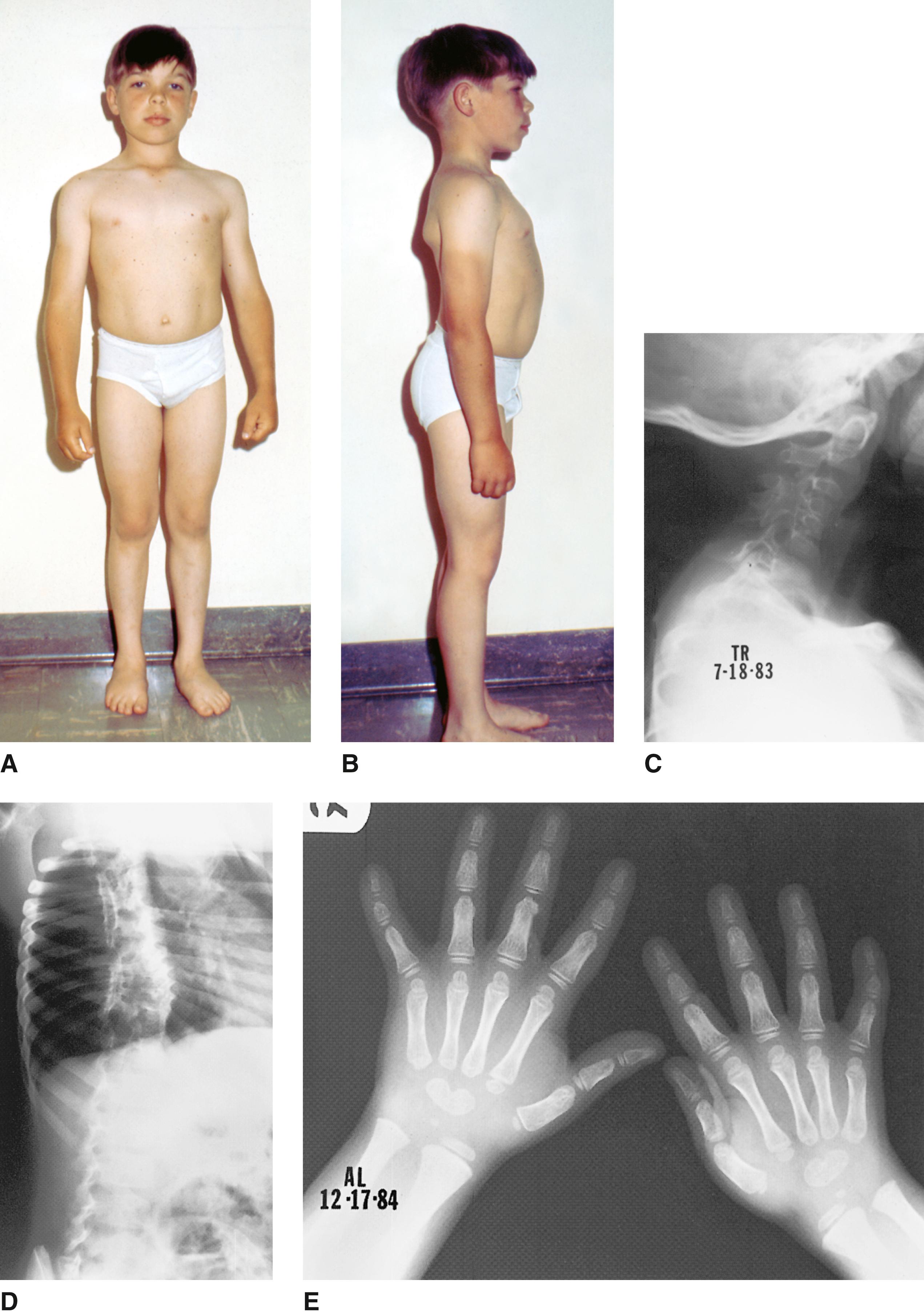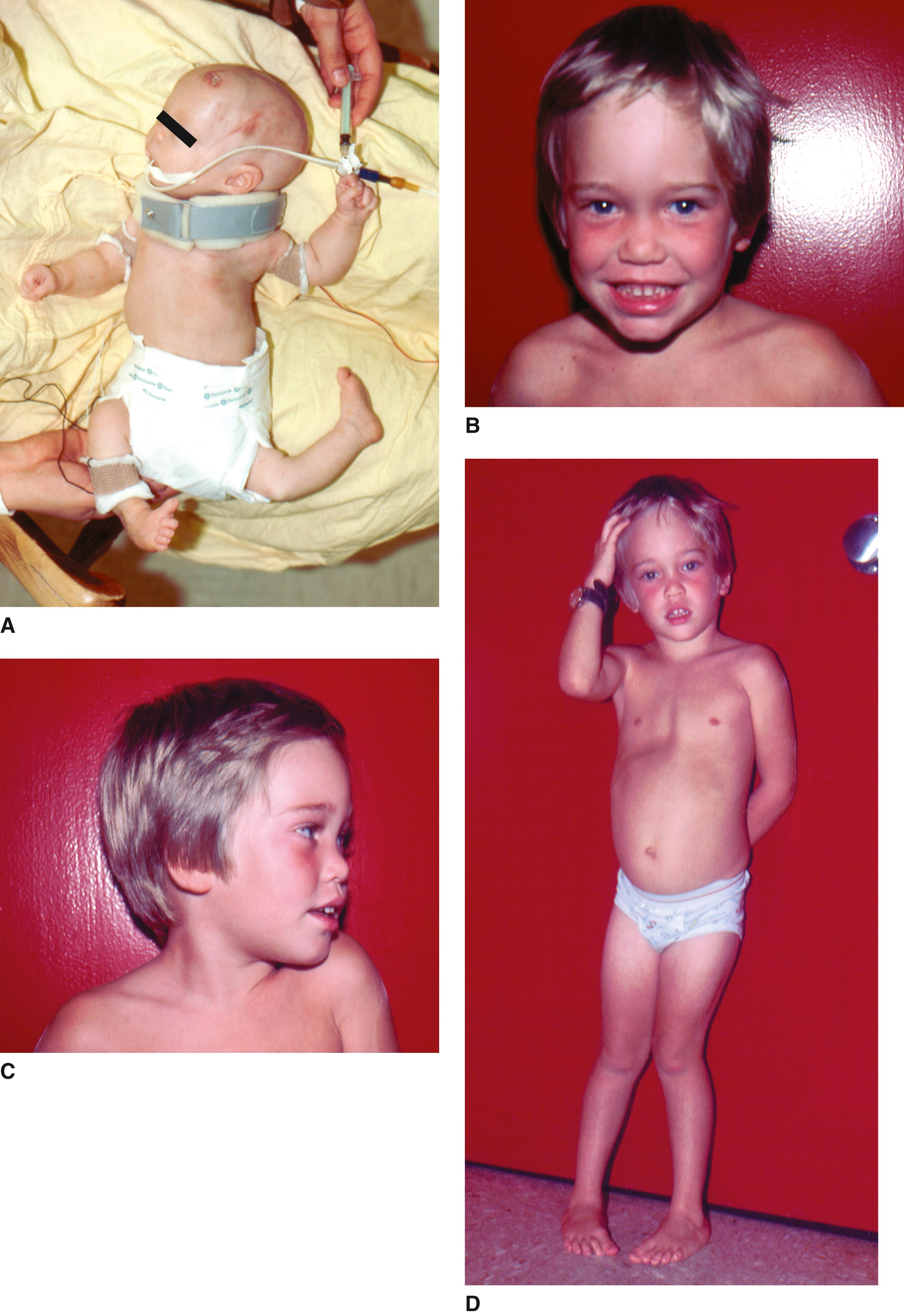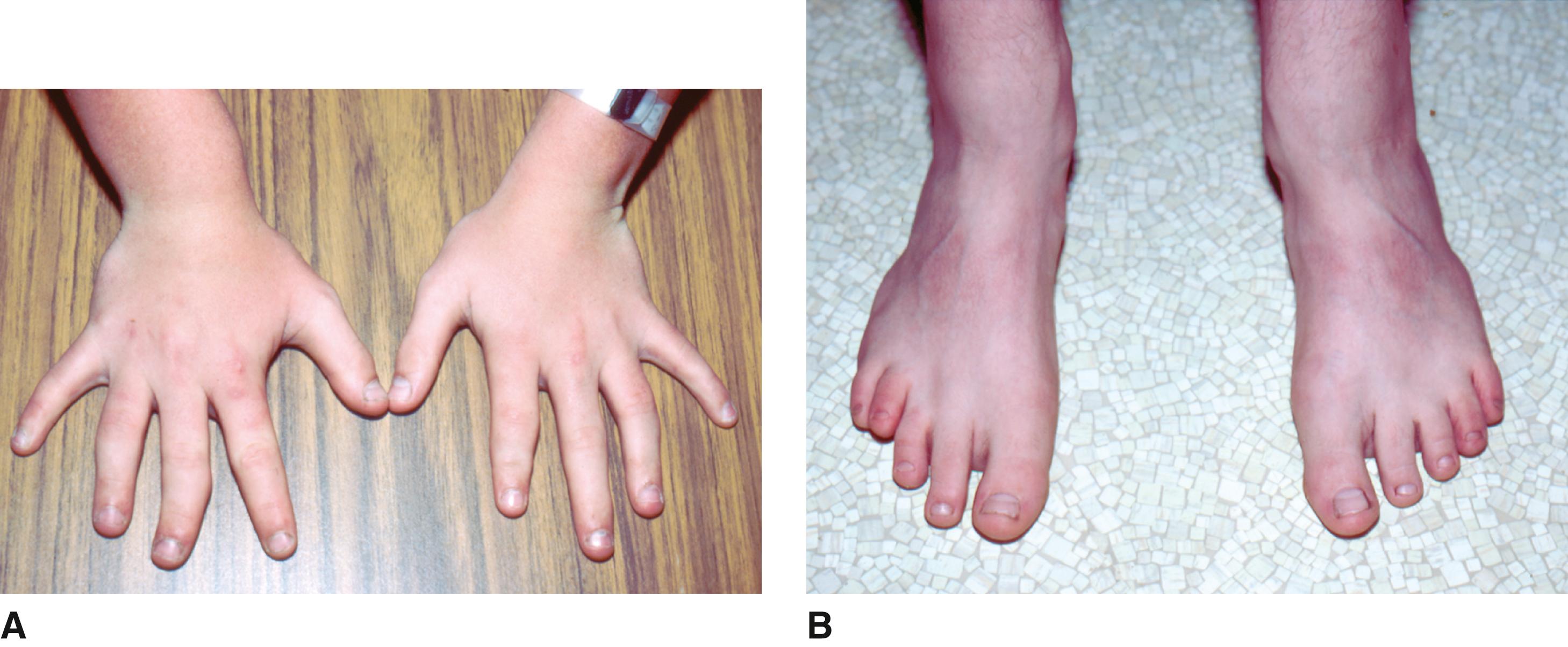Physical Address
304 North Cardinal St.
Dorchester Center, MA 02124
In the past this disorder was generally termed symphalangism (synostosis of finger joints), a nonspecific anomaly. The multiple synostosis character of this disorder was emphasized by Maroteaux and colleagues, based on the presence of characteristic facial features and more severe and widespread joint involvement, especially in the vertebrae and hips.
Craniofacial. Sloping forehead, prominent supraorbital ridges, broad nasal bridge, hypoplastic nasal septum, bulbous tip of the nose with hypoplasia of alae nasi, malar flattening, short philtrum, asymmetric mouth, thin vermilion of upper lip, hyperopia, strabismus, conductive deafness.
Skeletal. Limited flexion, extension, and lateral bending of the neck; pectus excavatum or carinatum; prominent costochondral junction; limited rotation of hips and abduction of shoulders.
Limbs. Limited flexion of interphalangeal joints with faint or absent interphalangeal creases; variable clinodactyly, brachydactyly, and distal bone hypoplasia or aplasia of distal phalanges; absent, hypoplastic, or short fingernails/toenails; cutaneous syndactyly; broad, short thumbs; limited forearm flexion/extension, and pronation/supination; short feet and broad hallux; inability to flex toes; deformity of heel; decreased range of motion of heel and foot; waddling gait.
Imaging. Multiple fusion of proximal and middle phalangeal joints (second to fifth digits); fusions of carpal and tarsal bones (especially navicular to talus); vertebral anomalies; fusion of the nasal bone and the frontal process of the maxilla; variable fusion of middle ear ossicles, most commonly fusion of stapes to the round window.
Moderate intellectual disability, Klippel-Feil anomaly, short sternum, humeroradial synostosis, good muscle development, short arms and legs.
Conductive hearing loss typically presents in childhood and may worsen later. Many cases are amenable to surgical correction. Hyperopia can be severe and should be looked for early in life. Symphalangism is not always present in childhood. Bony fusions are progressive and lead to increasing stiffness and limitation of movement of the spine and/or limbs, which is sometimes painful. Neurologic complications secondary to spinal canal stenosis occur frequently. Vertebral fusion, particularly in the cervical spine, can be debilitating.
This disorder has an autosomal dominant inheritance pattern with appreciable variance in expression. Mutations in the NOG gene that encodes noggin are responsible for the majority of cases. Noggin is an antagonist of bone morphogenetic protein (BMP). Mice lacking noggin fail to initiate joint development, which suggests that excess BMP leads to enhanced recruitment of cells into cartilage, resulting in oversized growth plates and failure of normal joint development. Genetic heterogeneity is present as mutations in three other genes, GDF5 , FGF9 , and GDF6 have been reported in a small number of families. Although the clinical phenotype is similar in individuals with all four genotypes, those with mutations in FGF9 lack hearing loss, and those with GDF6 mutations lack the dysmorphic facial features as well as symphalangism, humeroradial synostosis, and vertebral fusion defects.
The term NOG-related symphalangism spectrum disorder has been proposed to include the many different phenotypes related to NOG mutations, which include proximal symphalangism, multiple synostoses syndrome, stapes ankylosis with broad thumbs and toes, tarsal-carpal coalition syndrome, and brachydactyly type B2.

This disorder was delineated in 1994 by Langer and colleagues, who described six affected individuals and reviewed an additional six from the literature. Approximately 50 cases have been reported to date. Diagnostic criteria, which were set forth by Coelho and colleagues in 1998, include fusion of multiple cervical, thoracic, or lumbar vertebral bodies; carpal and/or tarsal synostosis; short stature and scoliosis and/or lordosis; and absence of rib anomalies.
Growth. Disproportionate short stature with short trunk; decreased upper-lower segment ratio.
Craniofacial. Mild dysmorphic features: round face with frontal bossing, anteverted nostrils; low-set, posteriorly rotated ears; conductive hearing loss owing to recurrent otitis media, sensorineural hearing loss.
Skeletal. Variable degrees of scoliosis and lordosis, most commonly involving the thoracic spine; short trunk; short neck with low hairline.
Limbs. Single transverse palmar crease, absent interphalangeal flexion creases, fifth-finger clino–dactyly, pes planus.
Imaging. Carpal synostosis, most commonly capitate-hamate and lunate-triquetrum; tarsal synostosis; block vertebrae; unsegmented bar.
Cleft palate; preauricular skin tag; ocular hypertelorism; short nose, with broad, square nasal tip; enamel hypoplasia; missing permanent teeth; decreased range of motion at elbows; odontoid hypoplasia, basilar invagination, platybasia, and stenosis of the foramen magnum; delayed ossification of many epiphyses as well as in carpal ossification; rib anomalies; broad humerus; femoral epiphyseal dysplasia; postaxial polydactyly; clinodactyly; sacral anomaly; clubfoot; renal cyst and other kidney anomalies; mild developmental delay.
Failure of normal spinal segmentation—which, when symmetric, leads to block vertebrae and when asymmetric, leads to unsegmented bars—causes most of the morbidity. Progressive scoliosis and lordosis, which are the major complications, are sometimes associated with restrictive lung disease. Cervical vertebral instability has been described. The unsegmented bar is difficult to identify on radiographs in early life because it is cartilaginous. Tomography is often helpful.
This disorder has an autosomal recessive inheritance pattern in most cases. Mutations in the gene encoding filamin B ( FLNB ) are responsible. FLNB seems to have an important role in vertebral segmentation, joint formation, and endochondral ossification. A few autosomal dominant families in which heterozygous mutations of MYH3 , which encodes the heavy chain of embryonic myosin, have been reported. MYH3 is also responsible for some cases of distal arthrogryposis 1 (DA1), DA2, DA2B, and multiple pterygium syndrome.

In 1950, Larsen and colleagues described six sporadic cases of this condition that has a clinically and radiographically distinct phenotype, and an autosomal dominant inheritance pattern. Subsequently three autosomal recessive forms of this disorder have been described with variable clinical phenotypes. Described below is the autosomal dominant form, which is most common.
Craniofacial. Autosomal dominant Larsen syndrome (LS): flat face with depressed nasal bridge and prominent forehead, hypertelorism; cleft palate.
Skeletal. Dislocations of elbows, hips, knees, and wrists; long, nontapering fingers; talipes equinovalgus or varus; cervical kyphosis; scoliosis, lordosis, scoliosis of lumbar spine. Autosomal dominant LS: short, broad, spatulate distal phalanges, particularly the thumb; short nails.
Imaging. Dysplastic epiphyseal centers developing in childhood, short metacarpals and multiple carpal ossification centers, delayed coalescence of the two calcaneal ossification centers, spina bifida and hypoplastic bodies of cervical vertebrae, wedged vertebrae, spina bifida occulta of sacral spine, anomalies of posterior elements of thoracic spine, dysraphism, spondylolysis, supernumerary carpal and tarsal bones, advanced bone age.
Intellectual disability; cleft lip; hypodontia; supernumerary teeth; gingival hyperplasia; periodontitis; conductive and sensorineural hearing loss; hypoplastic humerus; entropion of lower eyelids; anterior cortical lens opacities; simian crease; cardiovascular defect; mobile, infolding arytenoid cartilage; tracheomalacia; bronchomalacia; tracheal stenosis; cryptorchidism; malignant hyperthermia.
Prognosis is relatively good with aggressive orthopedic management. Many patients begin walking late. Osteoarthritis involving large joints and progressive kyphoscoliosis are potential complications. Airway obstruction caused by tracheomalacia and bronchomalacia may be life-threatening. All affected individuals should be evaluated for cervical spine instability. Particular care should be exercised during anesthesia because of the mobile arytenoid cartilage as well as the potentially dangerous spinal anomalies.
Autosomal dominant is the most commonly reported mode of inheritance. Mutations in the gene encoding filamin B ( FLNB ) have been reported in multiple families and in sporadic cases. FLNB seems to have an important role in vertebral segmentation, joint formation, and endochondral ossification. Mutations in FNLB also cause spondylocarpotarsal synostosis syndrome, atelosteogenesis types I and III, and Boomerang dysplasia.
Three different autosomal recessive forms of LS have been described. Larsen of Reunion Island was described in 1975. Clinical features of it include short stature, dislocation of large joints, ligamentous hyperlaxity, and characteristic facies, including a round flat face, prominent forehead, bulging eyes, and microstomia. Imaging studies reveal multiple joint dislocations, advanced carpal ossification, widened metaphysis and radio-ulnar-synostosis. Mutations in B4GALT7 are responsible.
In 2008, a second autosomal recessive form was identified, which is caused by deficiency of carbohydrate sulfotransferase 3 (also called chondroitin-6-sulfatransferase ) as a result of homozygous or compound heterozygous mutations in CHST3 . Clinical features include multiple joint dislocations, club feet, genu recurvatum, hip dislocations, and degeneration of the intervertebral discs. Neither the facial features of the autosomal dominant type nor cleft palate have occurred.
A third autosomal recessive type was described in two consanguineous Saudi Arabian families. Mutations in GZF1, which encodes GDNF1 -inducible zinc finger protein 1, are responsible. The clinical phenotype includes short stature, large joint hyperextensibility and dislocations, pectus carinatum, severe myopia, and retinal detachment.

More than 1000 cases have been reported. Prevalence is estimated to be 1 in 50,000.
Growth. Mild short stature, mean male adult height 170 cm (range 155 to 190.5 cm), mean female adult height 155 cm (range 127 to 173 cm); 37% of male and 44% of female heights are less than the 5th percentile. The pattern of growth is peculiar; preadolescents tend to be tall, 53% above the 75th centile, whereas 58% of the adults are under the 25th percentile.
Skeletal. Multiple benign cartilage-capped tumors (osteochondromas or exostoses) located most commonly around the knee, followed in frequency by the wrist, the proximal humerus, the proximal fibula, and the ribs; variable involvement of the scapula and pelvis; mandible and calvarium are normal; limb asymmetry and forearm bowing.
Lesions are usually not present at birth but become obvious between 2 and 10 years of age. A slowing of lesion growth occurs at adolescence and then ceases in adults. Remodeling defects caused by disruption of normal epiphyseal growth plate of the long bones lead to limb discrepancy and angular deformities. Involved bone may be relatively short, especially the ulna. Excessive growth or intense pain in the lesion should raise concern with respect to malignant transformation to osteosarcoma, less commonly other sarcomas, which occurs in 3% to 5% with an age ranging from 11 to 64 years. The majority of malignant transformations occur between 20 and 40 years of age; 56.2% are located in the pelvis and proximal femur. The issue of screening for malignant transformation is controversial. In one recent publication it was suggested that all patients between 20 and 40 years with Multiple Exostoses syndrome be screened annually with an MRI. However, there was no recommendation regarding an anatomic site to target. Two-thirds of patients have surgery for removal of at least one exostosis. For adults the mean number of exostoses removed is 3.5. Compression of peripheral nerves occurs in 22.6%, of blood vessels in 11.3%, and of the spinal cord rarely. Arthritis with mean age of onset of 36 years occurs in 14%. During pregnancy, changes in the exostoses occur in 10.5%. Other complications include bursa formation, usually presenting as a painful enlarging mass simulating malignant transformation, osteomyelitis, muscle impingement, hemarthrosis, pneumothorax, and hemothorax. More severe disease occurs in males than females, and in those with EXT1 as opposed to EXT2 mutations. Serial imaging to evaluate centrally located osteochondromas has been suggested, but the benefits do not clearly outweigh the risks of irradiation, in the absence of symptoms. This condition may significantly impact daily activities, as well as social and psychologic well-being. Bisphosphonate therapy has been tried for pain relief and to improve functioning.
This disorder has an autosomal dominant inheritance pattern. Three loci for hereditary multiple exostoses (HME) have been identified; EXT1 at 8q23-24, EXT2 at 11p11-p12, and EXT3 at 19p. This last locus may reflect a false–positive linkage result. A combination of sequencing and deletion analysis of the entire coding regions of both EXT1 and EXT2 detects mutations in 70% to 95% of affected individuals, more frequent in EXT1 (56% to 78%) than in EXT2 (19% to 44%). When multiple exostoses occur with intellectual disability and behavioral problems, two microdeletion syndromes should be considered: Langer-Giedion syndrome at 8q24 that includes EXT1 and TRPS1 , the gene for tricho-rhino-phalangeal syndrome type I; and Potocki-Shaffer syndrome or proximal 11p deletion syndrome, which includes EXT2 .
Some chondrosarcomas have demonstrated loss of heterozygosity of chromosomes 8q and 11p, which is consistent with the two-hit model of tumor development. EXT1 and EXT2 are tumor-suppressor genes.

Little’s report in 1897, limited to a presentation of the patellar defect, is usually credited as the initial description of this syndrome. This pattern is now known to include multiple other dysplasias of osseous and nonosseous mesenchymal tissues resulting in renal disease, glaucoma, and hearing impairment. The incidence of the disorder is estimated at 1 in 50,000.
Become a Clinical Tree membership for Full access and enjoy Unlimited articles
If you are a member. Log in here